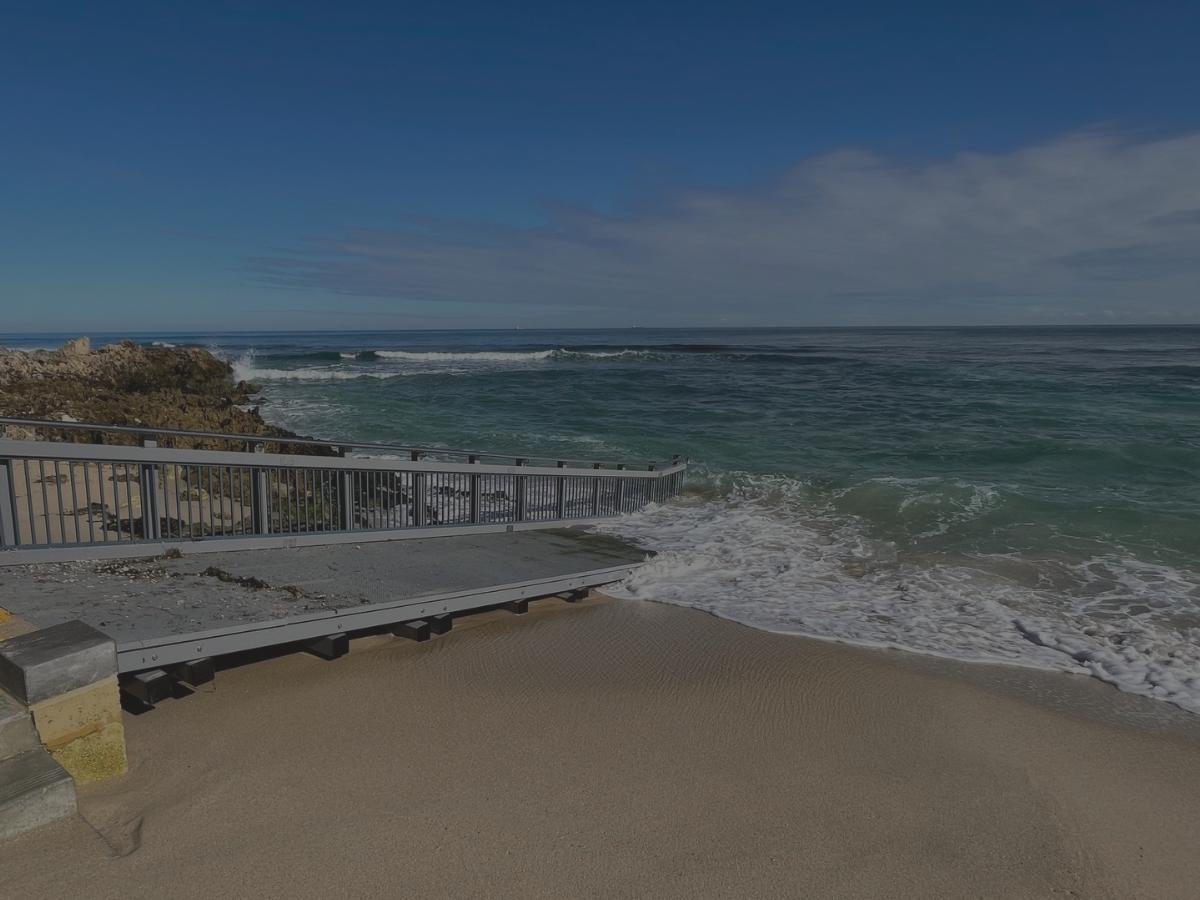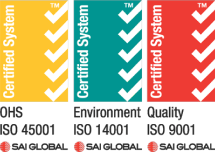Coastal environments present some of the most challenging conditions for infrastructure design.
Structures in these zones must not only withstand dynamic forces from waves, tides and storm surges but they must also be adaptable to shifting coastlines and long-term climate change impacts.
Magryn & Associates Technical Director and Senior Engineer, Will Souter predicts Fibre Reinforced Polymer (FRP) is the future of coastal infrastructure due to its strength, durability and corrosion resistance making it a smarter, longer-lasting alternative to traditional materials.
“Coastal environments are complex and every site has its own unique challenges. The coastlines are becoming more and more dynamic as a result of climate change and designing resilient and maintenance-free structures is more important than ever,” Will Souter said.
“Timber and steel have been used for a long time in coastal infrastructure but they’re susceptible to corrosion, degradation and have ongoing challenges,” Mr Souter said.
“Recent failures of timber structures due to storm surges serve as a stark reminder of the vulnerabilities inherent in traditional materials especially in marine environments and under wave loads,” he said.
“That’s where in this context, FRP has emerged as a compelling alternative offering durability, constructability and life cycle benefits in these types of structures along the coast.”
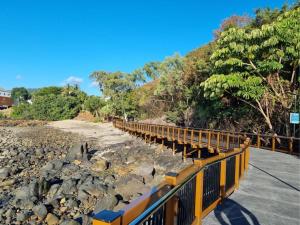 Pictured – Bicentennial Boardwalk in Airlie Beach, Queensland.
Pictured – Bicentennial Boardwalk in Airlie Beach, Queensland.
Before designing and constructing a coastal structure, Magryn & Associates Coastal Scientist, Freya Barr recommends having a thorough understanding of wave behaviour is a necessity.
“To understand nearshore coastal hydrodynamics, it’s important to first understand the generation of waves in the open ocean,” Freya Barr said.
“When waves blow over the ocean surface for a long enough period and distance they generate what is known as sea waves and when sea waves travel, they disperse and become more uniform in direction and frequency transforming into swell,” Mx Barr said.
“For anyone that’s familiar with surfing or enjoys spending some time down at the beach, you’d be familiar with what swell looks like. The approaching of successive waves in groupings towards the beach,” they said.
“As the swell propagates towards a coast, the waves transform as the water depth changes from deep to intermediate and shallow water.”
“The transformation process begins when the water depth becomes less than half the wavelength. The process of wave transformation ends when waves become unstable and break, dissipating their energy on the shoreline or coast.”
“The process of wave transformation includes a decrease in wave velocity and a decrease in wavelength as a result of the waves bunching up and an increase in wave height.”
“Wave transformation happens because the waves are affected by the seabed through processes such as shoaling, refraction and diffraction.”
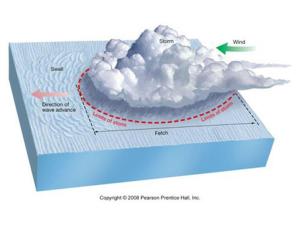 Pictured – Diagram of wave generation.
Pictured – Diagram of wave generation.
Beyond wave movement, one of the most critical and often underestimated forces impacting coastal structures is storm surges.
“Though not a wave transformation process, another nearshore coastal hydrodynamic that is important to understand and consider when designing for wave loads is the effect of storm surges,” Freya Barr said.
“A storm surge is the combined effect of wind setup and lowered atmospheric pressure in a storm centre,” Mx Barr said.
“Wind setup is an increase in the still water level at a coastline due to the wind induced shear stresses on the upper parts of water layers,” they said.
“When wind blows parallel to the ocean surface, it generates a wind directed current. When this momentum reaches a barrier such as a coastline, it piles up against the coast resulting in an increase to the water level.”
“Low atmospheric pressures such as those that occur in the centre of a storm reduce the atmospheric force pushing down on the water surface allowing it to rise slightly. This is referred to as the inverted barometer effect.”
“Combined together, wind setup and lowered atmospheric pressure from a storm can have substantial impacts on water levels at coastlines and therefore coastline structures.”
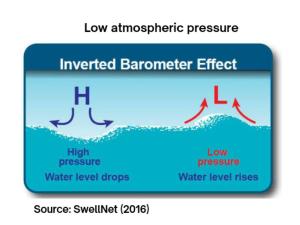 Pictured – Inverted barometer effect.
Pictured – Inverted barometer effect.
Understanding the complex interaction between waves and water levels is crucial when designing structures in nearshore environments.
“When designing structures located in the nearshore environment, it’s critical to understand that the highest waves do not always coincide with the highest water levels,” Will Souter said.
“As waves propagate into shallow water, they undergo transformation processes that can significantly alter the characteristics and the resulting loads,” Mr Souter said.
“When waves break onto a structure, this can impart very high impact forces and may exceed those generated under conditions at higher tides or certain parts of a structure may be subject to higher wave forces depending on the bathymetry of that point in the structure,” he said.
“As such it’s essential to evaluate a range of water levels and wave conditions to identify the critical design scenario.”
“There’s a large difference if you had something like a jetty structure located in a zone where most of the waves are within the wave zone compared to a zone where you’ve got higher wave crests in the nearshore as they begin to break and the elevation increases.”
“This raises a key question. Is it more cost effective to elevate the structure entirely above the wave zone or to design a more robust structure that can withstand wave forces while partially submerged.”
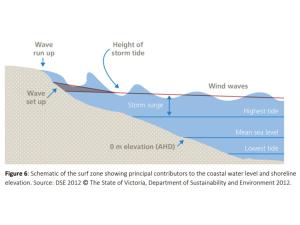 Pictured – Diagram of the surf zone.
Pictured – Diagram of the surf zone.
If structures are elevated to minimise the effects of wave forces, other key factors need to be considered.
“If we’re elevating a structure, it’s important to consider factors such as wave setup, nearshore wave transformation and potential sea level rise. If a structure must be located within the wave zone, special attention should be paid to the uplift forces,” Will Souter said.
“One strategy would be to incorporate porosity into the decking, so graded systems allow for the pressure to pass through, significantly reducing the uplift compared to solid decking,” Mr Souter said.
“A wave coming from an oblique angle or perpendicular might cause forces that are acting simultaneously across a large portion of the structure whereas waves coming in parallel would run along the jetty and there would only be parts of the structure impacted at one time,” he said.
“In regard to specific detailing of structures and how wave loads impact them, the drag coefficient plays a significant role in determining the wave induced forces. Profiles with higher drag coefficients such as flat or angular sections experience much larger forces.”
“Where possible, designers should consider using streamlined profiles such as circular piles or members with chamfered edges that have lower drag coefficients.”
“Also consider where there are wave loads on the structure to minimise the projected area in the critical wave zone.”
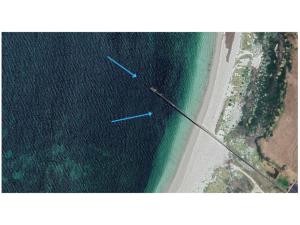 Pictured – The different angles of incoming waves.
Pictured – The different angles of incoming waves.
In addition to understanding wave-structure interactions, it’s crucial to account for how coastal environments may shift and erode over time.
“While understanding wave structure interaction is critical for estimating the loads, it’s equally important to consider how the coastline itself evolves over time over the life of the structure, particularly when you’re dealing with dynamic sandy coastlines like we have in a large portion of Australia,” Will Souter said.
“They’re subject to processes such as storm erosion and long-term recession,” Mr Souter said.
“For instance, a ramp or stairs that is supported by piles may be structurally sound under current levels but may in the future become undermined if the beach erodes,” he said.
“Similarly increased water depth due to long-term recession can expose more of a structure to wave action than originally anticipated. This can also amplify the wave loads.”
“To address this in the design phase, it’s recommended to conduct thorough investigations on the specific site such as surveying the beach, beach profile modeling where possible and reviewing trends.”
“This helps us forecast potential changes in the future allowing us to design structures that can accommodate.”
For more details on designing coastal structures with FRP, watch the full webinar ‘Designing for Wave Loads’ – https://youtu.be/FMAOb8pKQPQ
For Wagners CFT Design Guide – J7998_WAG_WCFT-Design-Guide-2024_WEB3.pdf
And to watch a webinar on how to use the Design Guide, visit – https://youtu.be/lBDHb5mqNjI
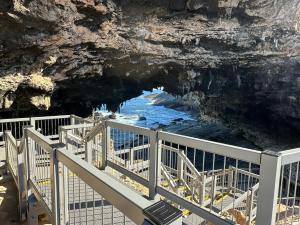 Pictured – Admiral Arch in Flinders Chase National Park on Kangaroo Island, South Australia.
Pictured – Admiral Arch in Flinders Chase National Park on Kangaroo Island, South Australia.
